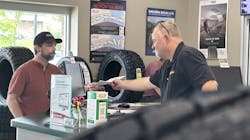After finally snapping seven straight months of negative trends in July, dealers indicate retail sellout trends turned slightly negative in August. But the key word here is slightly — as dealers reported retail sales fell 0.1% year-over-year. That’s a far cry from the low- and mid-single digit declines from the spring of 2022. But it is a decline after the 3.5% increase recorded in July.
Regionally, the results show a mixed bag. The Northeast reported the strongest trends, with a gain of 1.3% year-over-year, while the Southwest saw the softest trends, down 0.6% year-over-year. The other regions were basically flat.
So while this is technically a decline, we wouldn’t call the state of retail “bad.” Let’s call it “ok.” We continue to see trends that are marginally stronger than earlier in the year, and we believe the consumer deferment cycle is pushing more consumers to pursue needed auto repairs.
We’re also lapping softer sellout trends from a year ago, and that continues to work in favor of current trends. Despite the overall inflationary environment, which has been dragging down sales for much of 2023, there have been sequential improvements since April. Even with a slight step back in August, we would not be surprised to see sellout levels remain on the positive side of the ledger as we move forward, in part because of easier comparisons, but also due to a steady customer.
On the miles driven front, trends strengthened for a sixth consecutive month, and that gives us the first occurrence of six straight months of positive trends since October 2021 to March 2022. And while miles driven remain elevated on a year-over-year basis, we also see that our miles driven index suggests total miles driven have now reached pre-pandemic levels. And given the recent strength of the trends, we expect this to eclipse pre-pandemic levels. The early reports from September were adding to the positive momentum, with miles driven growing another 3% year-over-year, and that follows gains of 1.4% in August and 2.9% in July.
Given this continued strength in our proprietary index, we believe the tire replacement industry is seeing a stronger backup, which supports a recovery in sellout trends as 2023 winds down and we enter 2024.
As for the prices of the raw materials needed to build a tire, in August the prices of several raw material inputs increased month-over-month. The increases were in the low-single digits, but when looking at year-to-year comparisons, the price trends are still declining.
We still believe these declines are a welcome sign both for tire manufacturers and for dealers. But industry operators continue to tell us that dealers expect manufacturers to lower prices as these raw material prices decline. Based on this, it appears wholesale tire sales could lag for some time. It does appear that with raw material price hikes mostly behind us, there is the potential for price decreases and moderation on the horizon.
Looking ahead
Consumer demand for passenger and light truck replacement tires was again positive on a net basis in August, compared to August 2022. But there was a noticeable slip following July, when 70% of our dealer contacts saw positive demand trends. In August, it was just 11% of our dealer contacts.
But even with that, dealers were more positive than a year ago, when 67% reported negative demand. Only 22% of dealer contacts reported declining demand in August 2023.
Dealers still see the customer deferment cycle shifting towards the positive, and they expect that trend may continue as we turn to fall and winter weather is on the horizon. If weather trends worsened, we may see further acceleration in the consumer replacement rate, especially coming off a historically mild winter a year ago.
As for the mix in tire tiers, the uncertainty lingers. In August, tier-one brands were the most in-demand tires from consumers. In July, tier-one tires were in second place. Dealers continue to note the deferment cycle has begun to shift, though trade-down remains prevalent. Tier-two tires were second in demand, with tier-three brands in the last place in August.
Given what we continue to hear about consumers trading down, we were surprised to see tier-three tires taken the bottom spot again in our monthly rankings. From our view, we see this as an indicator of how the current economy is affecting some consumers. We still see consumers basis their choice off their current economic situation, which has been shown by the swings in our rankings over the last few months.





